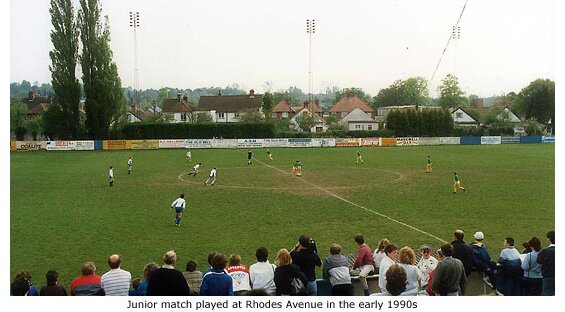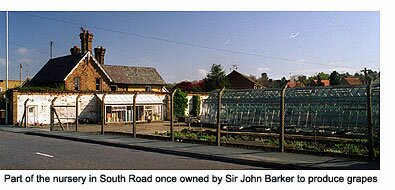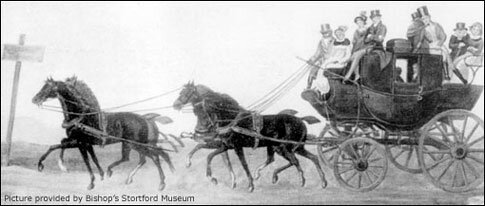
| UPDATES | GUEST BOOK | MEMORIES | MORE PICTURES | OTHER LINKS | BIBLIOGRAPHY | ||

Rhodes Avenue

After its formation in 1874, Bishop’s Stortford Football Club played mainly ‘friendly’ matches at Silver Leys – home to the town’s polo club – and between 1897 and 1900 used the Grammar school’s playing field at Hadham Road.
From there they went to a farmer’s field off of Havers Lane, and in 1903 moved to Laundry Field behind the Bishop’s Stortford Steam Laundry in Dunmow Road. Owned by Frederick Newey, and more popularly known as ‘Newey’s Laundry’, this stood opposite Hockerill College approximately where Urban Road is sited. The club’s changing room at this time was at the Falcon public house in Station Road.
Laundry Field remained the club’s home until the start of the First World War in 1914. No matches were played for the duration of the war, but when the club re-formed in 1919 the landlord of the Chequers Hotel, Joe Brazier, allowed them use of a piece of land he owned near South Road, known as Brazier’s Field. He’d bought the land from the Gilbey estate after Sir Walter’s death in 1915.
They played their very first match here on Saturday 4 October 1919, beating Ware 2-1 in front of a crowd of 400. At that time the only barrier between players and fans was a rope strung between posts around the pitch, and there was no shelter. The club president, Tresham Gilbey, later gave a wooden pavillion previously used by the polo club at Silver Leys.
In 1927 Brazier gave the club the opportunity to buy the land for £400. Fund raising was organized and when £300 was reached, Brazier accepted it. Some time later, a property developer building the Rhodes estate offered the club £1,100 for the site, but was refused.
Before Rhodes Avenue was constructed, entrance to the ground was via an alleyway behind the Thorley End goal, known as *’Sally Death’s Passage’. A wooden stand was erected in 1931, but not until the 1950s did fans have the luxury of covered terracing at each end of the ground. Ten years later the old stand was replaced by a new one seating almost 250 people, and dressing rooms and social facilities were added. The total cost of this refurbishment was £13, 282, and the ‘new’ ground opened on 24 November 1962. Floodlights were finally installed in 1967.
Around 1970 the name George Wilson Stadium was adopted in honour of the club chairman who had been a committee member since 1927. Dedicated fans, however, still referred to the ground as Rhodes Avenue.
Spiralling costs in the 1980s led to mounting debts and the club was eventually forced to sell their ground for property development. After 78 years on the site their last match was played in December 1997 against Ware, who they beat 2-1 – the same score as their very first match at the ground in 1919. The first match played at their new stadium at Woodside Park was in July 1999 (See Guide 10).
*Miss Sally Death lived at nearby South Lodge well into the 1920s, and was a prominent, unmistakeable, figure around the town, always wearing black.
Bishop’s Stortford’s branch of the Royal British Legion (See Guide 4) was founded in 1921 in a small building that stood behind the old football ground. Nearby Rhodes Avenue, Zambezi Road and Kimberley Close all take their name from Cecil Rhodes’s association with South Africa (See Guide 13).
At the corner of South road and Kimberley Close stands a rather unusual Victorian cottage. This was built towards the end of the 19th century by Sir John Barker to house the manager of his nursery that was also sited here. As founder and owner of Barkers department store in London (See Guide 7 – The Grange), he grew his own grapes for the store. But England’s weather was as unpredictable then as it is now, so in order to provide fruit all year-long the glasshouses in which they were grown were individually heated at different temperatures to promote growth all year round.
To keep budding wine makers at bay, the nursery was enclosed by a high wall that stretched northwards as far as Netteswell House (now the museum), and eastwards as far as South Mill Road. All that now remains of the wall is the small section alongside the cottage.
When Sir John died in 1915 the growing of grapes ceased and the land was sold, but it continued to be used as a plant nursery until 1931. By that time, though, its owners  were deep in debt and the nursery had to be sold off.
were deep in debt and the nursery had to be sold off.
One nurseryman, owed a great deal of money in back pay, was offered part of the nursery in lieu of what was due to him. This he accepted but, understandably, turned down the offer to buy more of the property through lack of finance. He became the first owner of the present-day nursery, which until recent years was owned and run by his son. The houses of Kimberley Drive are built on the original site of the main nursery.
|
Stagecoaches |
||
 |
||
|
In the early 1600s the only form of public transport was the carriers wagon or horse and cart. But by the 1660s the stagecoach, though still in its infancy, had made its entrance. The following entries are taken from four separate trade directories for Bishop’s Stortford, published in the early 19th century. Not only did these directories list the names of trade and business people in the town, they also included a timetable for privately owned stagecoaches leaving Stortford for London and the towns and villages of Essex and East Anglia. Note the marvelous names (in italic) that owners gave their stagecoaches. |
||
|
Kelly’s Directory 1846 |
||
